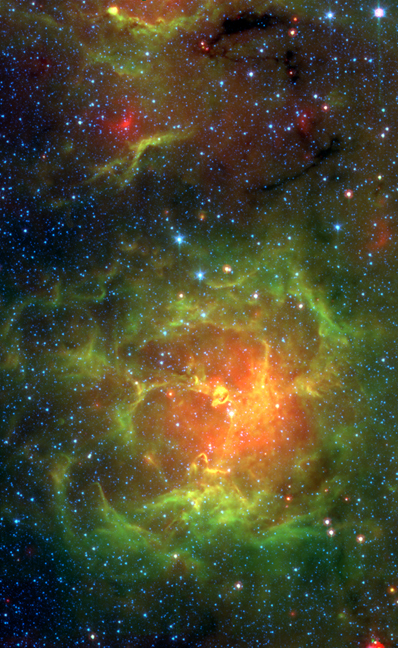


|

|
 |
|
Flickering ribbons shield star-forming gas KEITH COOPER ASTRONOMY NOW Posted: 16 March 2010 By all rights massive stars should emerge from their nebulous wombs stillborn, as their radiation heats the surrounding gas and stops the star from growing. Now new research has revealed that spiral filaments of gas act as a shield, absorbing the heat of young stars and allowing gas from beyond to continue to fall onto them. All baby stars have a ‘switching on’ point. Initially, as they condense out of a cloud of molecular hydrogen, they generate energy via gravitational collapse, but after a million years or so into their protracted birth their core temperatures become hot enough to ignite nuclear fusion reactions, and a real star is born.  The Trifid Nebula in infrared light, an incubator to a single massive, but still growing, star, surrounded by 30 much smaller embryonic stars. Image: NASA/JPL–Caltech/J Rho (SSC/Caltech). The Trifid Nebula in infrared light, an incubator to a single massive, but still growing, star, surrounded by 30 much smaller embryonic stars. Image: NASA/JPL–Caltech/J Rho (SSC/Caltech).
For lower mass stars such as the Sun this is not a problem – by the time they switch on they are just about done growing anyway. The most massive stars do face a problem however; as the nuclear fusion process begins within them, they are still growing from the accumulation of infalling gas. The star’s ultraviolet radiation should heat and ionise the surrounding gas, blowing it away on its stellar wind and preventing the star from growing further. How then do the most massive stars form? This puzzle has now been solved by a team of astronomers from the United States, Germany and Mexico. Using supercomputers at the Texas Advanced Computing Center and the Leibniz and Juelich Computing Centres in Germany, they modelled how gas would behave around a young massive star. They found that the gas does not fall evenly onto the star, but that over-densities form filamentary concentrations of gas, like immense spiral ribbons that gradually wind onto the star. These ribbons can absorb much of the young star’s radiation, shielding the rest of the nebula. The variation in these ribbons can cause the innermost regions to flicker like a candle over the course of hundreds of thousands, or even millions, of years. Recent studies have shown how magnetic fields play a major role in attracting gas onto a massive star along field lines (read our related news story here), and the team are currently performing simulations to measure the role of magnetic fields within the ribbons. However, team member Mordecai-Mark Mac Low of the American Museum of Natural History says that initial results indicate that magnetic fields do not have an effect on the formation of the radiation-absorbing ribbons. “For very massive systems, magnetic fields are likely to be far too weak to fight self gravity,” he tells Astronomy Now. However, magnetic fields may still be important in gathering in the material from the wider interstellar medium in the first place. |
|
|
|
|